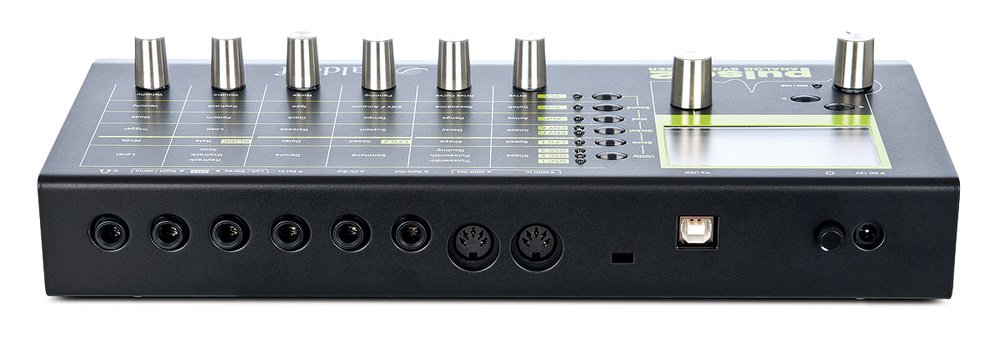Farewell to the Waldorf Pulse 2
I’ve recently been loaned a Studio Electronics Midimini V30. It’s huge beast of pure analog rawness, based on the original Minimoog. I pulled my Pulse 2 out because I thought it might be fun to compare a synth that costs 10% of the price and still going strong. The very next day the news that the Pulse 2 was being discontinued was released.
It’s been around for over 10 years now, but has flown under the radar for the past few years, mainly I suspect due to the torrent of new very knobby synths that have come onto the market. So if you’ve not come3 across one here’s a little breakdown.
The Waldorf Pulse 2 is a monophonic and paraphonic synthesizer that builds on the legacy of the original Waldorf Pulse, first released in 1996. The Pulse 2 features a powerful sound engine, an intuitive interface, and a robust set of connectivity options, making it a favorite among electronic musicians and producers alike. In this article, we will explore the Pulse 2's synthesis architecture, oscillator and filter types, paraphonic modes, and its development from the original Waldorf Pulse to its recent discontinuation.
Synthesis Architecture
The Waldorf Pulse 2 is a hybrid synthesizer that combines digital and analog technologies to create its distinctive sound. At the heart of the Pulse 2 is a three-oscillator architecture that allows for a wide range of sounds, from classic analog waveforms to complex digital tones. The oscillators can be set to pulse width modulation, sawtooth, triangle, and square waveforms, and can be detuned for thick, lush sounds.
The Pulse 2 also features a flexible filter section that includes a low-pass filter, a band-pass filter, and a high-pass filter. The filter can be set to 12dB or 24dB per octave, and resonance can be increased for a more pronounced effect. The filter section can also be modulated by an LFO or envelope generator, adding movement and dynamics to the sound.
In addition to the oscillators and filter, the Pulse 2 features two envelope generators, an LFO, and a modulation matrix that allows for extensive sound shaping. The modulation matrix enables users to route any modulation source to any destination, creating complex and evolving sounds that can be customized to fit any musical style.
Oscillator and Filter Types
The Waldorf Pulse 2 features three oscillators, each with its own waveform and tuning controls. Oscillator 1 can be set to pulse width modulation or sawtooth waveforms, while oscillator 2 can be set to triangle or square waveforms. Oscillator 3 can be set to pulse width modulation, sawtooth, or triangle waveforms. The oscillators can be detuned for thick, rich sounds, and can be used in unison mode to create massive, powerful tones.
The Pulse 2's filter section includes a low-pass filter, a band-pass filter, and a high-pass filter. The filter can be set to 12dB or 24dB per octave, and resonance can be increased for a more pronounced effect. The filter section can also be modulated by an LFO or envelope generator, adding movement and dynamics to the sound.
Paraphonic Modes
The synth also features two paraphonic modes, allowing for polyphonic and monophonic operation. In polyphonic mode, the synthesizer can play up to eight notes simultaneously, while in monophonic mode, only one note can be played at a time. The paraphonic modes can be used to create complex chord progressions and harmonies, or to play melodies with multiple notes.
Connectivity
It offers a range of connectivity options to help users integrate it into their studio setups. It features four CV outputs that allow for external modulation and control of parameters like filter cutoff, pulse width, and oscillator frequency. Additionally, the Pulse 2 has CV inputs that can be used to control its parameters from other CV-equipped devices. The synth also includes MIDI In/Out/Thru ports, which enable it to communicate with other MIDI devices, as well as a USB port for direct connection to a computer or mobile device. This range of connectivity options makes the Waldorf Pulse 2 a highly flexible and capable synthesizer for both live performance and studio production.
Development and Discontinuation
The original Waldorf Pulse was released in 1996 and quickly became a favorite among electronic musicians and producers for its powerful sound and intuitive interface. The Pulse was followed by the Pulse Plus and the Pulse 2X, which added additional features and functionality to the original design.
The Waldorf Pulse 2 was released in 2012 and represented a significant update to the original design. The Pulse 2 featured a new sound engine, an improved interface, and a robust set of connectivity options, including USB and MIDI connectivity.
Despite its popularity among electronic musicians and producers, the Waldorf Pulse 2 was recently discontinued. While the exact reasons for the discontinuation are not clear, it is believed that declining sales and increased competition in the market.
Does this make it a future classic? How many bits of kit have we seen quietly slip away only to resurface as a vintage classic? Waldorf’s own Microwave I springs to mind. Maybe its finally worth picking one up, if only as part of your retirement plan.
Here’s my little farewell :)


